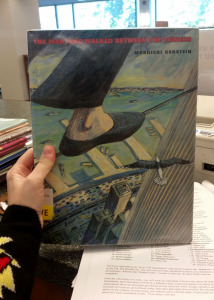
They didn’t give him a tank or a warship or an X-wing fighter, they gave him a call box from which you can call for help. Steven Moffat.
The little Spandrells are watching a show at the moment called Andy’s Prehistoric Adventures. In it, an odd looking man (all teeth and curls, like a young Tom Baker) who works in a museum, travels back to the time of the dinosaurs to have some mildly educative adventures. He travels in time via a grandfather clock, which sits incongruously on whichever ancient landscape it arrives in. A TARDIS rip off, if I ever saw one.
Except, it works in a different thematic way to the blue police box exterior of the TARDIS. The grandfather clock very clearly says, it’s about time, kids. But when they made Doctor Who, they didn’t give him a clock, they gave him a police box – an everyday sight, a public object, an outpost of authority and a very British innovation. It symbolised lots of things, but what it didn’t do was baldly state, this is a time machine.
So, no clock. And crucially, no telephone either. It had no communications link back to 1960s England, or indeed any of its destinations. This police box was cut off from everything. Classic Who was made in the days when to conceive of a telephone was to imagine your handset connected to every other one by a complex array of cables. No such cable stretched to Skaro or Marinus. In fact, it takes until Logopolis for the show to visually acknowledge that police boxes even had phones. The TARDIS certainly didn’t.
By the 21st Century, things have changed, and the TARDIS is as connected as any other aspect of our modern lives by telephony. By the phone in the police box’s little exterior cupboard, by the one on the console, by various companions’ mobiles and even by the Doctor’s. The Bells of Saint John takes its title from the TARDIS’s phone (the little cupboardy one) and from the life-changing call which comes through on it, from impossible girl Clara (Jenna-Louise Coleman) to the Doctor in medieval seclusion (Matt Smith).
This seems like a particularly Steven Moffaty trait. After all, he first used this conceit of the exterior phone unexpectedly ringing in The Empty Childand returned to it inThe Time of the Doctor. But it was his predecessor Russell T Davies who first put a phone in the TARDIS in World War Three. And his supercharging of Rose’s Nokia 3801 in The End of the World confirmed that in this new version of Who, our heroes were not as cut off from their homes and loved ones as their 20th century counterparts were. They could call across space and even time. Like E.T., they could phone home.
This makes sense. The Doctor has a machine which can traverse the universe and its entire history. Technology way beyond our grasp. Of course, he’d have a phone. It would be kind of weird if he didn’t.
But that’s not why the TARDIS is a phone box; it’s not a symbol of communication. It’s not a lifeline between us and the Doctor. It wasn’t, in its original conception, a place you could call to or from for help. In fact, because it was explicitly disconnected from everything else in the universe, the fact that the police box had a useless phone reinforced how isolated our heroes were. The one thing they couldn’t do was call for help.
It may seem like a small detail, but giving the TARDIS telecommunications changes the show. Once you can, ahem, call the Doctor, he becomes the hero you can summon when needed. Winston Churchill, for instance, calls directly through to the console. Clara calls when she needs help cooking a turkey. It’s the show’s equivalent of Batman’s bat signal. Phone him up and our hero comes running. Add this to our modern Doctors’ ability to steer the TARDIS with pinpoint accuracy, and we really are a long way from the show’s beginnings, where the police box was a cosmic lifeboat, tossed on the waves of time and space, directionless, contactless and utterly isolated.
****
Telephones and computers, and what they might do to us, was the source of much concern in 1966’s The War Machinesand it’s nice to see how little has changed by The Bells of Saint John. There’s always mileage for Doctor Who in technophobia, it’s just that by 2013, that fear is centred on wifi. There’s still a big tower though, from which the bad guys can broadcast their evil, brain harvesting scheme.
The Shard, like the Post Office Tower back in ‘66, represents another concern of modernity. In The War Machines, it was technology itself which grew a mind of its own and got ideas above its base station. Here, it’s technology wielded by a corporation, from within a monolith celebrating capitalism. It’s the stuff of conspiracy theories; shadowy suits manipulating us with a casual swipe up or down on an iPad. They can even make aeroplanes fall from the sky. This is playing on very contemporary fears.
It makes sense that here is where the Great Intelligence should make its return. Being a formless yet sentient spirit, it seems right that it now should lurk within the Cloud, like some particularly malignant piece of code. Certainly, it seems more fitting than in The Snowmen, where it represented the Victorian fascination with the paranormal (if you squint). Funnily enough, though, that’s what the Intelligence was in its 60s conception – a mystic supernatural presence from beyond the astral plane, not a ghost hiding in the machine. But – spoiler alert – we’ll get there is a couple of posts’ time.
For now, let’s just reflect on another of this episode’s big flashy statements. Never mind a telephone, this Doctor’s got serious technology and a motorbike! He rides up the side of the Shard with only a perfunctory line about anti-gravs to cover the implausibly of it all, running straight over the shiny surface of capitalism with those big rubber tyres. “Can he actually do that?” asks an astonished supporting character. Dude, this guy’s an ancient alien superhero with a time machine, a magic wand and a direct line through to his snog box. What can’t he actually do?
Yup, times have really changed.
LINK TO Amy’s Choice. Both Matt Smith stories, and hooray for an easy link.
NEXT TIME…God save the Queen, it’s Empress of Mars.
Advertisements Share this:




